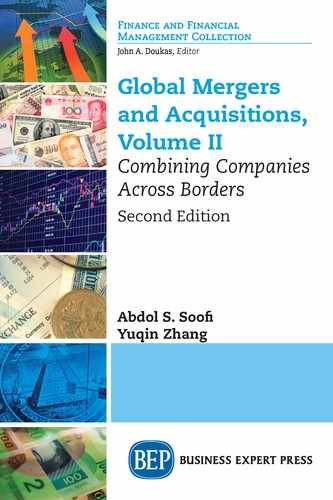Reviewing the M&A literature, one comes across a fragmented field of inquiry. One can recognize different patterns in the development of the M&A literature according to the disciplines of the researchers. The research interests in M&A and corporate restructuring literature are primarily concerned with the following questions. Why do companies merge? Are M&As successful in achieving the goals of acquisition and combinations? Why do so many companies fail to create shareholder value or capture the synergies they inspired to gain? How to best value the target firm? What role does postmerger integration play in the postmerger performance of the acquiring and acquired companies? What role do corporate and societal cultures play in the success or failure of M&As? The literature on M&A deals with these and many other questions.
The fragmentary nature of the literature emerges from the discipline-based approach researchers take in answering the questions. One finds articles with emphasis on economics of M&A (economies of scale, market power, and shortcut to obtaining costly technology) written by economists; articles written by strategic management scholars, focusing on motives for acquisition and postmerger performance according to the motives of consolidations; and articles written by scholars in corporate finance, concentrating on postmerger performance based on stock market indicators. Studies by researchers on organization theory project attention on postmerger integration and conflicts arising during the integration processes and, finally, experts on human resources have focused on effective communication, cultural differences, and socio-psychological issues that might have an impact on the success or failure of the combined entities. Based on this, it is common knowledge among the scholars of M&As that the discipline-based approach used for answering any of these questions leads to answers that tend to differ and, in some cases, even contradict each other (Larsson and Finkelstein 1999).
In the first volume of this book, we review the literature of M&A from different angles and bring together valuable, practical insights from this vast literature in a short, but cohesive form that hopefully has great managerial relevance.
Structure of the Second Volume of the Book
Volume II of the book consists of two parts: Parts II and III.1 Part II of the book involves discussions of outbound M&A activities of China’s enterprises, which until the last few years only involved state-owned enterprises. In Chapter 14, after a discussion of outward FDI by Chinese companies, we review factors that have contributed to outward M&A investment by China. Furthermore, the chapter examines the role of the Chinese government in promotion and regulation of outbound M&A activities of Chinese enterprises. Moreover, the chapter reviews the accounting method of business combinations in China.
Chapter 15 examines major issues in Chinese cross-border M&A activities including postmerger experiences of Chinese firms, rules for overseas acquisitions by Chinese firms, perceptions of Chinese executives in acquiring firms in developed countries, policies of host countries toward Chinese firms acquiring businesses in their countries, and experiences of Chinese firms in outward investment and acquisitions.
Part III of the book contains the case studies all relating to China’s outbound acquisitions that had experienced legal, cultural issues.
_____________
1For an overview of 13 chapters in the first volume of the book, please see the introduction to the first volume.
